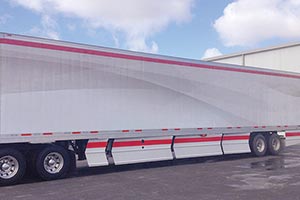Trailer OEMs Are First Group to Face New GHG Mandate

This story appears in the Aug. 22 print edition of Transport Topics.
Trailer manufacturers are the first companies serving the trucking industry that will have to meet provisions of the new federal greenhouse-gas rule.
The final rule issued Aug. 16 by the Environmental Protection Agency and the National Highway Traffic Safety Administration said a trailer is “an integral part of the tractor-trailer vehicle that significantly contributes to the emissions and fuel consumption of the tractor.”
The phased-in trailer portion of the rule begins in 2018, whereas truck and engine makers won’t see mandates until 2021.
The 2018 segment institutes standards for long-box (53-foot) dry and refrigerated vans that can be met “with common tire technologies and SmartWay-verified aerodynamic devices, and standards for the other regulated [nonvan] trailers based on tire technologies only,” the rule stated.
“In this early stage, we expect that manufacturers of trailers in the other trailer subcategories will meet their standards by using tire technologies only,” the rule said, referring to low-rolling-resistance tires.
The rule said trailers should contribute to fuel economy and lower emissions of carbon dioxide and other greenhouse gases in three stages: 5% in 2021, 7% in 2024 and 9% in 2027 — all based on comparisons with a 2017 baseline.
EPA and NHTSA also offered cost projections, saying the additions probably will add about $860 to the cost of a 2021 trailer, $1,015 to the cost of a 2024 unit and $1,090 for a 2027 model — again, all compared with 2017 levels.
North America’s two largest trailer makers said they expect to hit the standards.
“Our goal in this process was to work collaboratively with the agencies to simplify compliance while maximizing environmental benefits and overall cost savings for the fleets. I think we’ve achieved that,” said Richard Giromini, CEO of Wabash National Corp.
“Wabash will continue to pursue new technologies and develop new aerodynamic solutions to further improve fuel efficiency, reduce the operating costs of our customers and work to develop practical solutions that benefit all stakeholders,” he added.
“We are assessing the ruling this week and will be working with our customers and distributor partners over the next few months to explain Great Dane’s solutions and to offer guidance to the end users of our trailers,” said Chris Hammond, executive vice president of sales for Great Dane Trailers.
He said Great Dane has been preparing “for this well in advance of this week’s ruling.”
As trailers do not produce emissions directly, the rule said improvements will be measured a different way.
Truck makers have to compute a coefficient of aerodynamic drag for their vehicles. Trailer makers will have to do the same and then compare that with their 2017 models, thereby producing a change- in-drag statistic.
The rule also calls for tire-pressure devices. The preferred method is an automatic tire-inflation system, but the final rule also allows — but with less credit — the use of tire-pressure monitoring systems, which were not endorsed in the proposal.
The rule also said trailer makers will not be allowed to use the average/bank/trade program of emissions credits, as do truck and engine makers.




